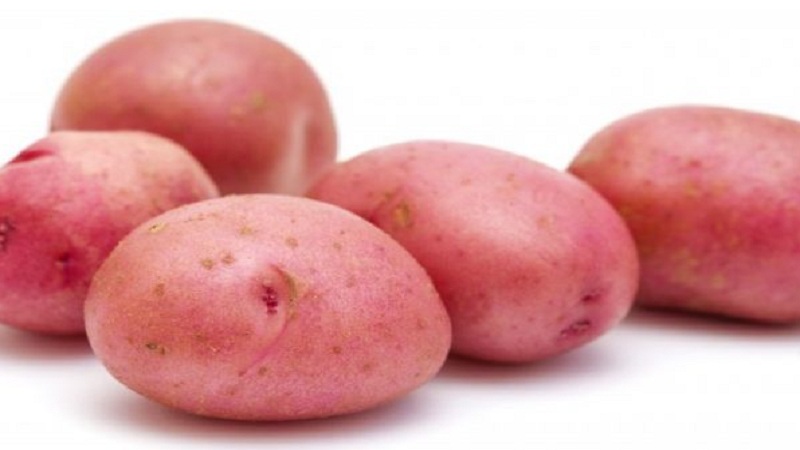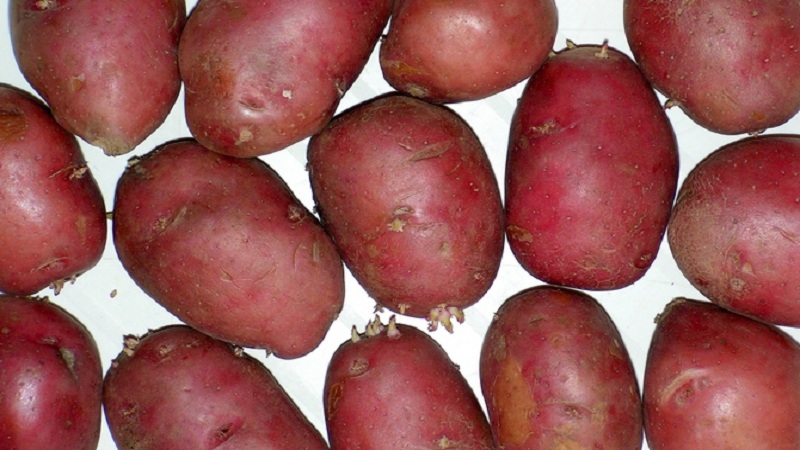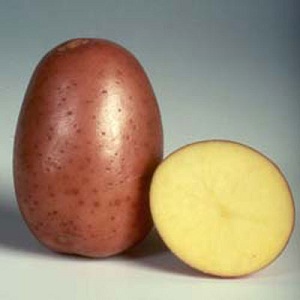Early maturing, frost-resistant potato variety "Rosalind"
Rosalind is especially popular with gardeners who prefer pink-skinned potatoes with yellow flesh. Early ripening allows you to harvest twice a season. Due to the optimal starch content, various dishes are prepared from the tubers, used for dietary nutrition.
In the article, we have prepared for you information about the Rosalind potato with a description of the variety, methods of its cultivation, prevention and treatment of late blight, getting rid of insect pests.
The content of the article
Description of the variety
Rosalind potatoes are the result of the work of German breeders from EUROPLANT Pflanzenzucht GmbH. The variety was included in the state register of the Russian Federation in 2002 in the Central Region, but in 2016 it was excluded due to the refusal of the originator from the patent.
In the photo - Rosalind potatoes.

The table contains the distinctive features of the variety.
| Indicators | Characteristic |
| Ripening period | 50-65 days |
| Bush | Tall, semi-erect, intermediate type |
| The number of tubers in the bush | 10-16 |
| Weight | 60-115 g |
| The form | Oval-rounded, with small superficial eyes |
| Coloration | The peel is red, the flesh is yellow |
| Leaves | Medium open, green |
| Corolla color | Red purple |
| Starch content | 12-17% |
| Taste | Excellent (5 on a five-point scale) |
| Cooking class / group | B (medium friable) |
| Yield | Average rate - 203-223 c / ha, maximum - 259 c / ha |
| Marketability | 89-94% |
| Keeping quality | 94% |
| Appointment | Dining room |
| Sustainability | Cancer, golden nematode and leaf roll virus, wrinkled mosaic |
| Transportability | High |
Chemical composition
In the table, you can see the vitamin and mineral composition of raw, unpeeled potatoes (per 100 g of product).
| Element | Content | Norm |
| Beta carotene | 0.001 mg | 5 mg |
| Vitamin B1 | 0.081 mg | 1.5 mg |
| Vitamin B2 | 0.032 mg | 1.8 mg |
| Vitamin B4 | 12.1 mg | 500 mg |
| Vitamin B5 | 0.295 mg | 5 mg |
| Vitamin B6 | 0.298 mg | 2 mg |
| Vitamin B9 | 15 mcg | 400 mcg |
| Vitamin C | 19.7 mg | 90 mg |
| Vitamin E | 0.01 mg | 15 mg |
| Vitamin K | 2 μg | 120 mcg |
| Vitamin PP | 1,061 mg | 20 mg |
| Potassium | 425 mg | 2500 mg |
| Calcium | 12 mg | 1000 mg |
| Magnesium | 23 mg | 400 mg |
| Sodium | 6 mg | 1300 mg |
| Phosphorus | 57 mg | 800 mg |
| Iron | 0.81 mg | 18 mg |
| Manganese | 0.153 mg | 2 mg |
| Copper | 110 mcg | 1000 mcg |
| Selenium | 0.4 μg | 55 mcg |
| Zinc | 0.3 mg | 12 mg |
Growing regions and climate requirements
The Rosalind variety is intended for cultivation in the following regions of the Russian Federation:
- Central;
- Volgo-Vyatsky;
- Central Black Earth;
- North Caucasian;
- East Siberian.
Advantages and disadvantages
The variety has many times more advantages than disadvantages:
- frost resistance;
- adaptation to any climatic conditions;
- high market value;
- great taste;
- amicable maturation;
- early maturity;
- keeping quality;
- disease resistance;
- the ability to get two crops per season.
The disadvantage is a predisposition to late blight of tubers and tops.
Features of planting and growing
The culture is undemanding to the type and composition of the soil, but the best result can be achieved when grown on light soils (sandy loam, loamy), rich in organic matter and minerals.
Planting care - traditional, provides for moderate watering, loosening the beds, weeding weeds, fertilizing.
Preparing for landing
Sprouting tubers before landing allows you to shorten the germination period and increase productivity. Seed material is taken out of the storehouse into the light, treated with disinfecting solutions with potassium permanganate, copper sulfate, "Fitosporin" and left in a bright room at temperatures above + 14 ° C. Under these conditions, seedlings appear in about 14 days.
24 hours before planting, potatoes are soaked in growth stimulants "Epin", "Zircon", "Poteyn", "Stimpo", "Regoplant" according to the instructions on the package.
Ground requirements
The site chosen for planting potatoes is prepared in the fall. The soil is dug up, harrowed, loosened and humus is introduced. In spring, the land is sown with green manure plants: rye, lupine, peas, flax, wheat, oats.
After a month, the seedlings are mowed and shallowly embedded in the ground. Overripe plants loosen the soil, saturate with oxygen, nutrients and inhibit the growth of pathogenic microflora.
Timing, scheme and landing rules
Disembarkation dates depend on climatic and weather conditions. In the regions of the middle zone, planting work is carried out in early May, in the southern regions - at the end of April, in the northern ones - in mid-late May.
Prepared seeds are covered with seedlings upward to a depth of 8-10 cm with an interval of 30 cm. The distance between rows is 70 cm.
On the site, holes are formed for a shovel, a handful of wood ash and superphosate are added to each. They cover them with earth from above, level the beds, but do not tamp them.
Interesting fact. The third President of the United States, Thomas Jefferson, offered French fries as a treat for the first time. The dish immediately became mega-popular.
Care
Potato care rules:
- Watering... Rosalind gratefully responds to moderate watering, increasing productivity. In regions with a temperate climate, there is enough rainwater; in the southern regions, plantings are watered by hand or through a drip irrigation system every 10–12 days. In drought, the frequency of watering is doubled.
- Mulching. Covering the beds with straw, hay, sawdust, needles retains moisture in the soil and stops the growth of weeds.
- Loosening and weeding... The procedures are carried out without fail. The beds are loosened after each watering to prevent the formation of a hard crust. Weeding is carried out regularly, preventing weeds from rooting.
- Hilling. This is a standard potato care routine that should not be neglected. The first hilling is carried out after the sprouts reach 10 cm, the second after flowering.
- Top dressing. Potatoes are fed with fertilizers with a minimum nitrogen content, with an emphasis on mineral compositions.
The table shows an approximate feeding scheme.
| Application period | Top dressing | |
| 1st portion | During the period of green mass gain | A solution of chicken manure in a ratio of 1:15. Consumption per bush - 500 ml. |
| II portion | During budding | 10 g of superphosphate, 10 g of nitrate, 10 g of potassium sulfate per 10 liters of water. Consumption - 500 ml per bush. |
| III portion | During flowering (foliar) | 20 g of granules "Mag-bor" per 10 liters of water. Consumption - 5 liters per one bush. |
Disease and pest control
Rosalind potatoes are prone to late blight of tops and tubers. The spread of the fungus is facilitated by excessive soil moisture and low air temperature. Timely preventive measures taken will help prevent infection:
- control of nitrogen levels in the soil;
- compliance with the rules of crop rotation;
- cleaning of weeds and potato tops;
- disinfection of tubers in potassium permanganate, "Oksigumate", "Fitosporin-M";
- feeding with potassium and phosphorus;
- treatment of plants with Bordeaux liquid, milk serum with iodine.
At the first symptoms of infection, the potato tops are cut off, the bushes are sprayed with Oksikhom, Ridomil, Gamair, Metaxil, Bravo, Planriz. At the stage of tuber formation, the bushes are irrigated once with "Alufit".
The fight against the wireworm is carried out using:
- insecticides "Aktara", "Bazudin", "Prestige", "Diazinon", "Thunder", "Thunderbolt", "Zemlin";
- adding onion peels to each well;
- watering the bushes with herbal infusion: 200 g of nettle, 100 g of dandelion and coltsfoot, 50 g of celandine in 5 liters of warm water - leave for 24 hours.
For the destruction of the Colorado potato beetle, a lover of crunching juicy potato tops, a highly effective drug "Prestige" is used. It contains the fungicide pencycuron, the insecticide imidacloprid. In the finished solution, the tubers are soaked before planting.
Ladybirds and dragonflies are attracted to the site, beans, nasturtium, marigolds, and valerian are planted. According to gardeners, all of this together is highly effective.
There is another interesting way to deal with colorado - their own poison contained in the bodies of insects. A jar with a capacity of 0.5 liters is completely filled with beetles and larvae, then poured into a bucket of 10 liters, poured to the brim with water, tightly closed with a lid, and left for 4-7 days. The infusion is diluted with water in a ratio of 1: 2 and the plants are sprayed.
Important! Use rubber gloves and protective clothing.
Collection, storage and use of the crop

The first digging of potatoes is carried out in July. The tubers fully ripen at the end of August. The variety does not have high yields, but at the same time it has an attractive presentation.
The collected tubers are cleaned of soil and left to dry in the shade for 3-4 days. Then they are sorted, discarding the damaged ones, with signs of rot.
The crop is stored in a cellar at a temperature of + 2 ... + 3 ° C and an air humidity of 70-80%. On a balcony or loggia, potatoes are stored in double boxes made of wood or plastic, which are inserted into each other. Styrofoam is placed in the gaps for the purpose of insulation.
Tubers can be stored in large boxes insulated with foil screen. The container is installed on a hill so that the bottom does not touch the cold floor in winter.
In specialized stores, “balcony cellars” with heating are presented to the attention of buyers. They look like large hiking backpacks, are powered by mains power and can withstand temperatures as low as -40 ° C.
Rosalind has a bright taste and attractive presentation due to its red peel and yellow flesh. Moderate starch content allows cooking with these potatoes boiled, fried, stewed, baked dishes. Tubers do not darken during cooking.
The nuances of growing and possible difficulties
Difficulties in growing the variety do not arise even for beginners. The plant adapts to any type of soil.
In addition to the traditional method of growing potatoes, the Dutch method is used. For planting, a site with a deep arable layer is chosen, since the tubers are sealed to a depth of 10-15 cm. The first sprouts are immediately spud. As soon as the seedlings appear above the surface, the procedure is repeated.
The row spacing is 70-80 cm, the gap between the holes is 25-35 cm.
The advantages of the method:
- The tubers are located above the soil level, since they use the soil from the row spacings for hilling.
- The combs receive sufficient heat and oxygen from the sun.
- During the period of prolonged rains, the bushes do not die from an excess of moisture, the water flows into the aisles.
- During drought, a sufficient amount of moisture remains in the ridges.
Planting care is standard, it provides for watering, loosening, weeding, feeding. To remove weeds, use herbicides "Titus", "Centurion", "Lazurit".
The plot is watered three times per season: before flowering, after 10 days, after flowering.
Tips and Feedback
Experienced gardeners speak positively about the Rosalind variety and share tips for growing.
Taras, Pavlovsk: «I have been growing Rosalind's potatoes for a long time. The variety is liked for its unpretentious care, long shelf life and the ability to harvest early. Tubers are all as for selection, aligned, medium size. When cooking, the skin does not crack, the pulp does not fall apart. I use bone meal for feeding.It maintains flowering, promotes rapid tuber formation. "
Daria, Vyazma: “I've been planting Rosalind for three years in a row. I got the seeds from a local farmer, I really liked the look. Caring for bushes is no different from caring for other varieties of potatoes. I prefer to close the tubers not deeply - 5 cm deep, sprouts up. I know that potatoes like to breathe. I throw a few beans into the hole to stimulate plant growth and scare off beetles. "
Read also:
Early ripe table potato variety "Colette".
Conclusion
Rosalind potatoes were highly appreciated for their excellent taste, almost simultaneous ripening of tubers, which are formed in large quantities on one bush. They are distinguished by uniformity in size and weight, excellent presentation and long-term keeping quality.
The culture tolerates short-term frosts, adapts to any climatic conditions and soil type. The variety cannot boast of high productivity, but attracts with stable ripening on time. Gardeners prefer Rosalind because of the ability to harvest two crops.